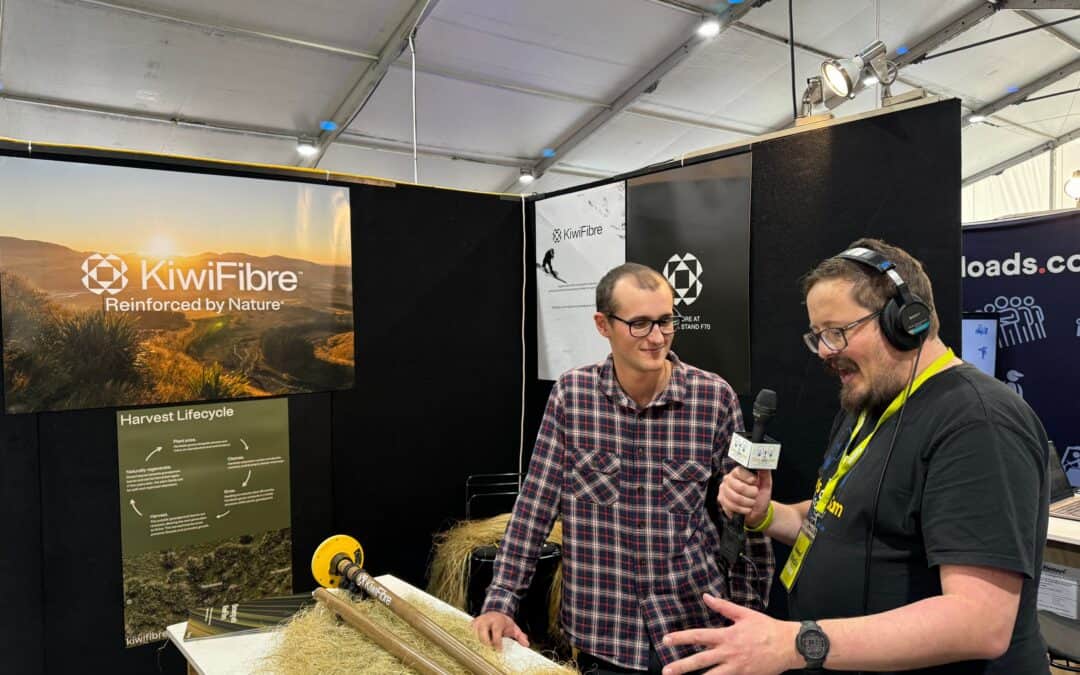Summary
Sam catches up with Oscar at KiwiFibre, winner of the Early-Stage award at Fieldays for their regenerative composite textile made from Harakeke fibre.
Find out what kinds of products this could be used for as a replacement or to complement conventional carbon fibre and fibreglass materials.
This is a great story about using naturally occurring fibres while providing an environmentally superior planting material for commercial growers.
We hope you find this interview as interesting as we did.
Links
Photos
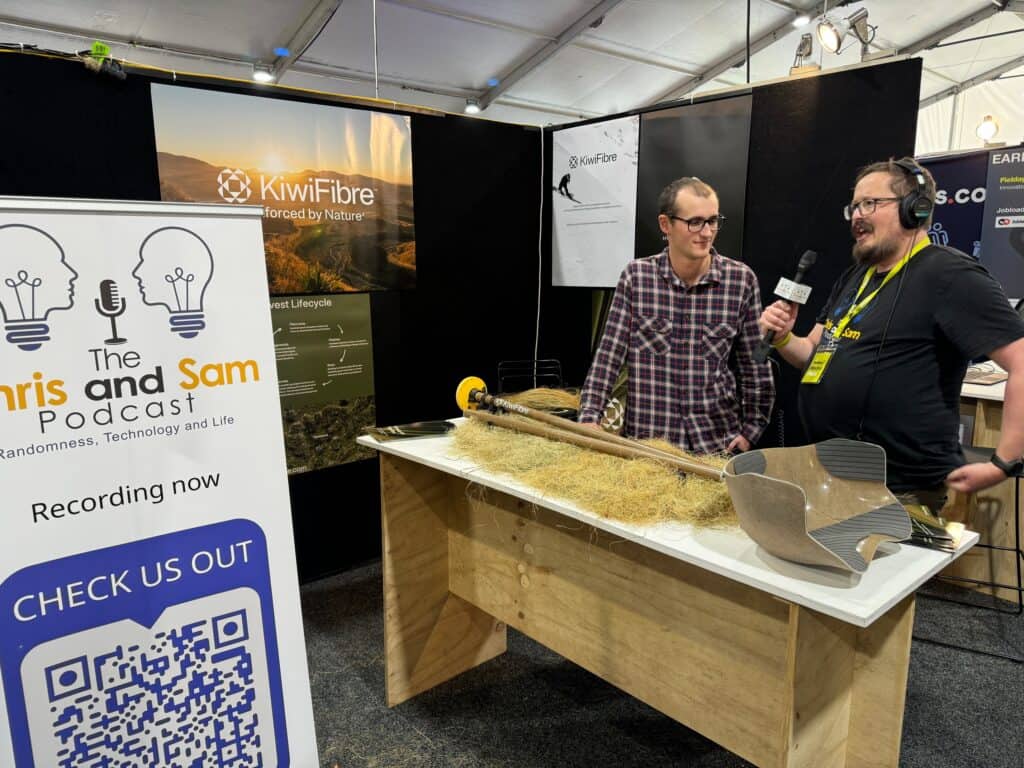
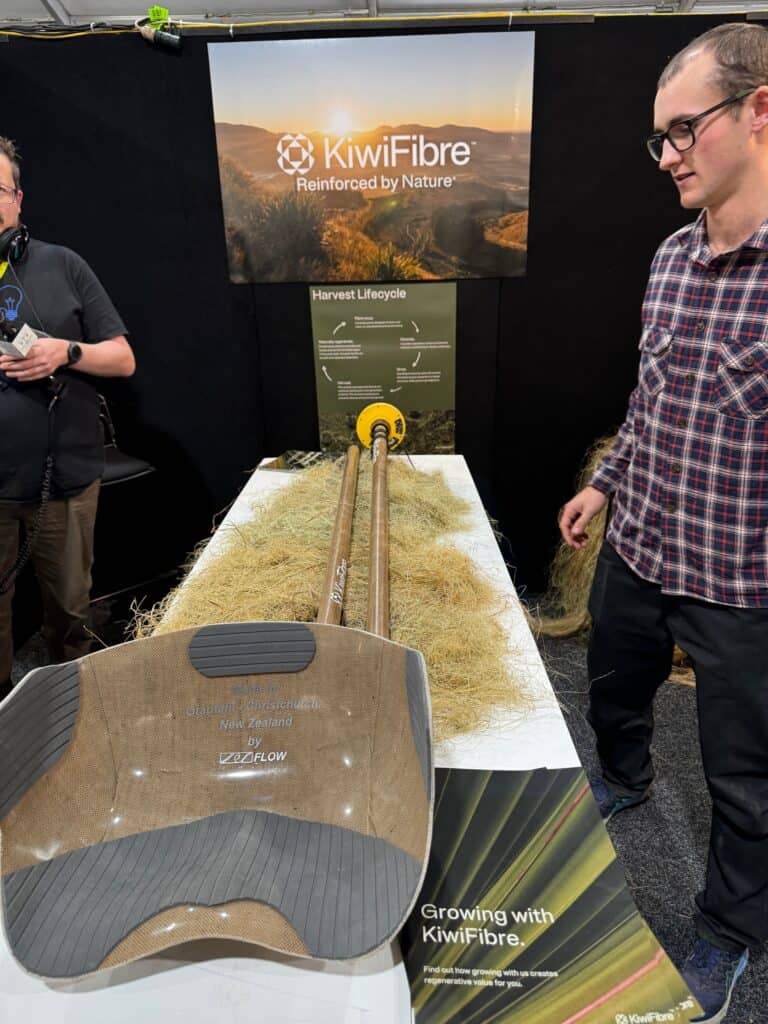
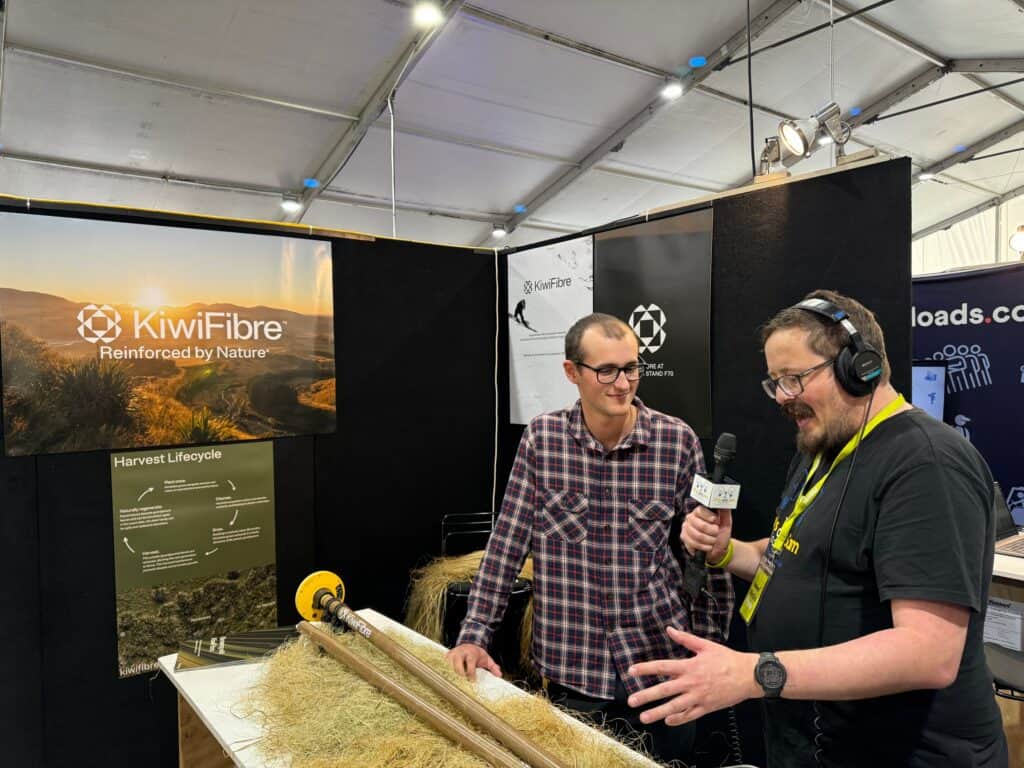
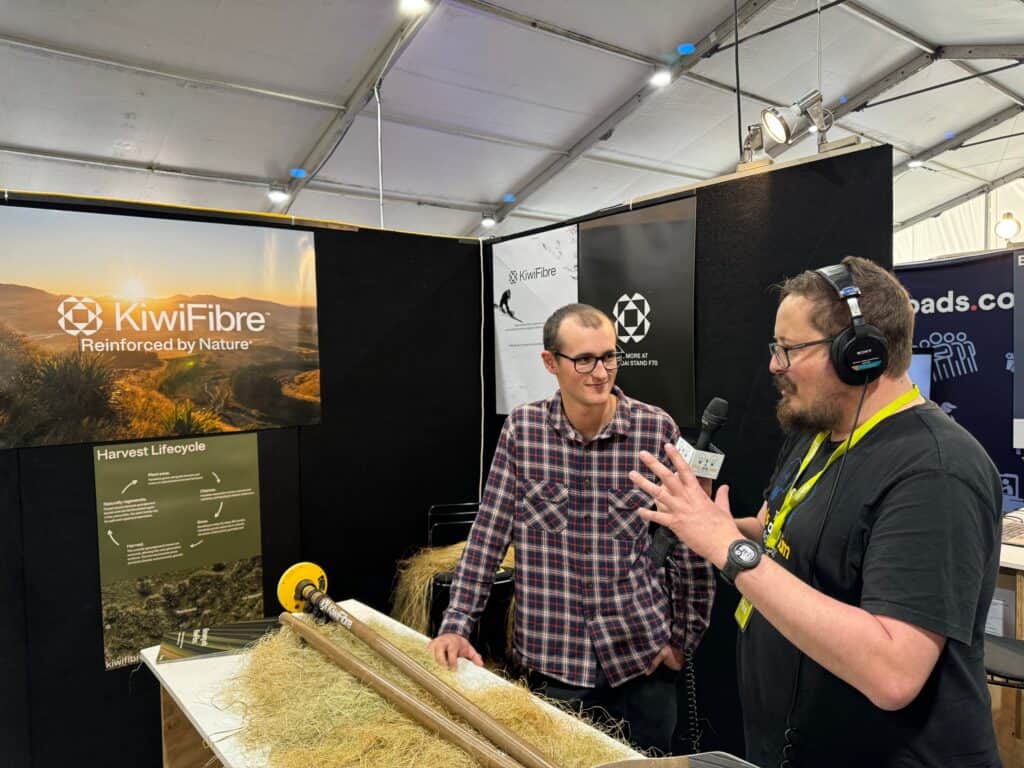
Show Transcript
This transcript was generated by an AI and may not be 100% accurate. If you have questions about any of the information found here, please reach out to us.
Sam [00:00:21]:
Hello, everyone. Sam here at field days 2024, and I am here with Oscar at Kiwi Fibre. Now, they do say it is a grower’s story and reinforced by nature. And from what I understand, and I could be completely wrong here because we’re going in completely cold, they are using flax fiber, or harikeke, and they are using it to make products very similar to how you may use, fibreglass. Is that correct or wrong?
Oscar [00:00:46]:
That’s correct. So creating composite materials from Harakeke Fibre for replacing carbon fibre and fibreglass in Global Industries.
Sam [00:00:55]:
Now you’ve got 2 examples on the table here. I’ll do my best to paint a picture with my words. First off, it looks like a seat?
Oscar [00:01:02]:
Correct. It’s a kayak seat made by, mates at
Sam [00:01:05]:
Flow Kayaks. Excellent. And you’ve got a 2 pole structure here, and that is a GPS receiver on the end, I think.
Oscar [00:01:14]:
Yes. So this is a survey poll, where we’ve worked with Trimble to create.
Sam [00:01:19]:
Excellent. So let’s start with your background story. How did you get from the idea to Field Days Innovation?
Oscar [00:01:26]:
So Ben and Will, who are the co founders, they started, well they came across the idea back in uni in about 2021. They were doing a waste design project for their industrial product design degree. Got given the task of creating a product using a natural fibre. They came across Harakeke, that project did well. And The, they did more research into the market and the need for a solution for the problems that carbon fiber and fiberglass has around the people, and the plant, and also performance. You know, the fiberglass and carbon fiber are terrible to work with, The give you splinters, you know, you’re breathing in fumes the whole time, and then, you know, for every tonne of CO2 that’s produced, there’s 20 tonnes of every tonne of carbon fibre that’s produced, there’s 20 tonnes of CO2 that’s released into the atmosphere. Oh, okay. So those are some big problems themselves.
Oscar [00:02:28]:
And then also, you know, carbon fibre, and fibreglass have performance limitations that we solve as well. So Ben and Will they became full time, end of 2022 where they raised 1 and a half mil. And then, you know, people like me, I came on board at September last year, to to add my skill set to the team.
Sam [00:02:51]:
And what is your skill set, Oscar?
Oscar [00:02:53]:
I do a little bit of design, machinery design, and then I work with growers to build the back end supply for for The that we can create the textile at the end of the day.
Sam [00:03:06]:
If you were talking about fiberglass and then the Harakeke, do you need a lot more of this fibre composed to fibreglass or is it sort of, I don’t even know if this is the right question, but is it like for like?
Oscar [00:03:19]:
It’s pretty like for like, yeah. So like you
Sam [00:03:21]:
don’t need like 10 tonnes of this to?
Oscar [00:03:23]:
No so we can drop in directly into a fibreglass or carbon fibre The, as long as they’re using a textile, the customer’s using a textile, and then for fibreglass we’re the same strength relatively, and then we have half the weight.
Sam [00:03:39]:
Yes, this pole here is super lightweight.
Oscar [00:03:41]:
Yeah, for carbon fiber, we’re slightly lighter, not as strong, but we bring a, a, you know, improved energy absorption and vibration dampening properties into that lightweight realm of carbon fibre, as well as radio transparent properties which allows our customers to engineer some pretty cool products.
Sam [00:04:03]:
This is all sounding amazing. I mean what’s the downside, I guess it’s just supply of raw material?
Oscar [00:04:10]:
Yes to an extent. It’s quite a manual process in harvesting. So like our growers, you know, they don’t have the capacity, you know, in terms of workforce to, harvest and supply leaves a lot of the time, so so we take that burden for them. We we solve that problem. So, you know, there’s a lot of lot of work done, that we’re doing in in making this value chain work, as easy as possible for every stakeholder in the chain. And, yeah, there’s a lot of positives.
Sam [00:04:40]:
There is, yeah, this is great. We at Field Days, we’ve been here a couple of years, we’ve seen a bunch of hemp based products, sort of, usually clothing, and there’s obviously a lot of wool based products, and we’ve seen that baked into everything known to mankind. I think there’s a few here today as well. Seems to be and from what I understand there was the price dropped out in wool and it’s an abundance of it and people are trying to use it, but you guys are using a natural product and turning it into products that are, you know, great.
Oscar [00:05:14]:
Yeah. So, the Harakeke industry was New Zealand’s first and biggest industry for a long time. It really stopped in the 1970s. That’s when The it it fully stopped. We used to create ropes, you know, New Zealand used to create ropes which were the premium ropes on the international market. And it all stopped because of, price competition from other fibers internationally. We couldn’t we couldn’t we couldn’t compete at all. Once subsidy subsidies, you know, retired, the industry came to a halt.
Oscar [00:05:48]:
New Zealand’s in a unique position with Harakeke because the fibre is so unique on the world stage, where hemp and linen, know, they’re strong fibres, they’re applicable, but, you know, Harakeke is a 3 meter long fighter, almost. You don’t find that anywhere else. And you also can’t find Harakeke many other places apart from New Zealand. So we’ve got a unique moat, we’ve got a unique value chain that we can foster in New Zealand to really offer differentiated, high value products on the world stage.
Sam [00:06:20]:
What’s the next step for Kiwi Fibre?
Oscar [00:06:23]:
So we’re in the midst of our $2, 000, 000 pre seed round, if I’m correct. Don’t quote me on that.
Sam [00:06:30]:
That’s alright. We’re pretty fluid with facts and figures when we do our normal podcast.
Oscar [00:06:36]:
So we’re raising 2 mil at the moment to invest into our scaling our supply chain. And we’re looking to have products ready for our customers by the end of the year.
Sam [00:06:46]:
I have a couple of questions just to end with. I know, Maori have a strong connection with, obviously, Harakeke. Did you have to find the right partners to harvest it the correct way, and was that a big process or not really?
Oscar [00:07:02]:
So Harakeke, in order to align with tikanga, is a fairly simple process in harvesting. What we do is we harvest the fan by only removing the tupuna leaves, the grandparent leaves, and leaving the Awhi rito and rito leaves behind to then grow. And, you know, we also don’t, harvest during the rain or at night. So, yeah, we make sure it’s very strict in our harvesting The we are aligning with tikanga.
Sam [00:07:36]:
That’s very cool. I will ask you, in any of your processes, it’s a big story, I guess, around the world in general, have you used AI or thinking of you using AI in some part of this process?
Oscar [00:07:48]:
Yeah. Yeah. There’s, you know, there’s scope for AI in every part of the process. Right? You know, it’s all manual harvesting at the moment. There could be an AI robot that goes and harvests for us, 1 day, but, you know, there’s a wide wide scope there to create, you know, efficiencies throughout our value chain, and and we’ll work to integrate those as as we
Sam [00:08:13]:
can. And finally, do you listen to podcasts, Oscar?
Oscar [00:08:15]:
I don’t listen to your podcast at the moment and I’ll start. And I I do but I do listen to podcasts a lot.
Sam [00:08:21]:
Give us your top 3 podcasts. It can be any genre. It doesn’t matter. We wanna know.
Oscar [00:08:26]:
Oh, I’m pretty generic. Joe Rogan. Yep. There’s some good good value in that. I listen to Lex Friedman quite a bit.
Sam [00:08:34]:
He likes long form content.
Oscar [00:08:35]:
Yeah. Long form content. And, who’s another? I was listening to a couple fellas oh, I forgot the The was a hunting podcast.
Sam [00:08:47]:
Okay.
Oscar [00:08:47]:
Okay. Yeah. Okay. But You’re still
Sam [00:08:48]:
with New Zealand based?
Oscar [00:08:49]:
Yeah. New Zealand based. I think The a bit from down in Canterbury. The, but, yeah. They they were doing it for a bit, and now I think they stopped. But I want them to keep going. It’s bloody good content, good value.
Sam [00:08:59]:
Excellent. Thank you so much for talking to the Chris and Sam podcast. KiwiFibre, amazing product. I look forward to seeing it everywhere. Thank you so much. Thank you.
Where you can find us
Get Patreon Perks
Our Facebook Page
Visit us on Instagram
Chris’s Website
Sam’s Website

